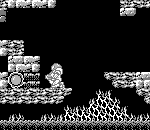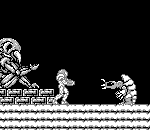Data
Guides and strategies
Media
Metroid II: Return of Samus review
![]() Metroid II is a bit of an oddity. Back in its day, the NES Metroid had existed for quite a few years before this sequel arrived. Nintendo chose to develop it for the portable Game Boy, rather than give the NES a second mission for bounty hunter Samus Aran. While this platform switch brought with it a few changes, Metroid II also introduced a number of new features for the series (some of which persist to this day), and gave us a fantastic story lead-up to the legendary Super Metroid.
Metroid II is a bit of an oddity. Back in its day, the NES Metroid had existed for quite a few years before this sequel arrived. Nintendo chose to develop it for the portable Game Boy, rather than give the NES a second mission for bounty hunter Samus Aran. While this platform switch brought with it a few changes, Metroid II also introduced a number of new features for the series (some of which persist to this day), and gave us a fantastic story lead-up to the legendary Super Metroid.
This time Samus' mission brought her to the fabled homeworld of the parasitical Metroids - SR388. Deemed too dangerous to exist by the Galactic Federation, the destruction of all remaining Metroids fell to Samus' capable hands. We join her as she travels deep under the surface of the planet, hunting down and ridding the universe of the life-sucking Metroids before they threaten galactic peace.
The game launches players right into the SR388 hunt beside Samus' gunship - and this is our first glimpse of her interstellar craft - it really does look like an oversized version of her helmet. Players are granted a small arsenal of Missiles and the Morphing Ball right off the bat, so there is literally no time wasted getting into the swing of the game.
Metroid II's gameplay mechanics and general layout score points for both building on the success of the original NES game and for taking things in a slightly different direction. The game world is completely open in a similar manner to planet Zebes from the NES title, although this time players work their way progressively forward in a more-or-less linear path.
Deadly obstacles barring the path forward will clear as players rack up their Metroid tally, and Samus is always free to backtrack right back to her starship up on the surface. This doesn't give the game as much depth as the original in terms of sequence-breaking and leaving things up to the player to discover their way through the adventure, but somehow on a portable console it just works - probably thanks to a bit more laziness and less thought needed on the player's part, but portable games always work so well when you can just pick them up and get straight into it.
![]() Despite the basic mission objective and linear path, the game branches out into multiple Chozo Ruin-esque areas filled with all sorts of items to find. Treasure-hunting is aplenty, and all the abilities found in the first game plus a few new surprises await players hidden in the planet. The classic Space Jump and Spider Ball abilities marked their debut in Metroid II, to name just a few. Sadly a map feature is still painfully absent, so getting lost is an unfortunate hazard for unwary travellers. But slowly and systematically working your way through the tunnels and caverns is an absolute joy and is incredibly rewarding with so much to find. The game also features three battery-backed up save slots, so no need to keep track of clumsy passwords - but the trade-off is no more weird "Justin Bailey"-style passwords to play with anymore.
Despite the basic mission objective and linear path, the game branches out into multiple Chozo Ruin-esque areas filled with all sorts of items to find. Treasure-hunting is aplenty, and all the abilities found in the first game plus a few new surprises await players hidden in the planet. The classic Space Jump and Spider Ball abilities marked their debut in Metroid II, to name just a few. Sadly a map feature is still painfully absent, so getting lost is an unfortunate hazard for unwary travellers. But slowly and systematically working your way through the tunnels and caverns is an absolute joy and is incredibly rewarding with so much to find. The game also features three battery-backed up save slots, so no need to keep track of clumsy passwords - but the trade-off is no more weird "Justin Bailey"-style passwords to play with anymore.
Ironically, we can thank Metroid II's lack of colour on the monochrome Game Boy for Samus' now-standard bulky Varia Suit design. The original NES simply switched Samus' orange colour palette to pink, but no luck for the Game Boy's colourless screen. This led Nintendo's artists to reinvent the Varia Suit - with the very design that lasts to this day. Besides Samus herself, the visuals are all nicely rendered with welcome touches like a starry backdrop on the surface of the planet and a distinct configuration for Samus' Missile Launcher.
Physically, the local wildlife of SR388 tends to be on the small side, but it's great to see the planet teeming with such a large variety of life. Giving the Metroids of this world a complete evolutionary cycle also keeps the challenge fresh and works well as an alternative to unique boss fights. The only downside is the occasional glitchy controls; with little room to move around in Samus can move quite stiffly at times - not a good thing when angry (and evolved) Metroids bear down on your head.
![]() Atmosphere is a Metroid title's bread and butter. At times the musical score challenges its very meaning by becoming nothing more than odd beeping sequences with healthy intervals of silence, but this is an alien world so anything goes. As players work their way deeper and bring the Metroid count closer to zero, the atmosphere definitely takes on a Tourian-like theme of its own - and the surprises awaiting Samus won't disappoint.
Atmosphere is a Metroid title's bread and butter. At times the musical score challenges its very meaning by becoming nothing more than odd beeping sequences with healthy intervals of silence, but this is an alien world so anything goes. As players work their way deeper and bring the Metroid count closer to zero, the atmosphere definitely takes on a Tourian-like theme of its own - and the surprises awaiting Samus won't disappoint.
Nintendo have given us a simpler but still atmospherically sound second outing in Samus' bounty hunting life. With the rarity and availability of Metroid II these days there's likely plenty of Metroid fans who missed this one back in the day. While the ending seamlessly sets the stage for the big act in Super Metroid, the game is still worthwhile as a piece of Metroid history. Don't be afraid to track down a copy and try out this fun diversion - it's perfect for a dreary Saturday afternoon. Then you can find out where and how Samus happened upon that all-important Metroid hatchling...
Written by Falcon Zero on 23 May 2010.















